
The Rediffusion Building
The ground gloor was occupied by the Sales Stall and the Planning and Mapping Sections of the Engineering Staff. An impressive reception room, with its counter at the back could be seen from the street through plate windows. These windows extended from floor to ceiling for the whole length of this side of the building. The workshop, stores. etc. were in out-buildings which enclosed a large courtyard at the rear. Commercial and Programme
Staff occupied the first floor and the second was given over completely to programme origination. Located here was the Central Control Room, three Studios, each with a separate Balance and Control Cubicles, a Record Library, Filing Office, two Record Rehearsal Rooms and a Record Cutting Room. Other recording facilities available included a mobile console containing a dual tape recorder made up locally which could be wheeled into any cubicle to record or play from tape as required and a third portable tape recorder.
The whole of this floor had been sealed off and air-conditioned, thus bringing the temperature down to 75’f, quite chilly and contrasted sharply with that outside.
A system of ring wiring, which connected together the Balance and Control Cubicles, Recording Room and Central Control, comprised an eighteen-pair cable for programme circuits and other cables for cue lamp signals, telephones. and slave clock impulses.
The programme pairs were brought out to a go-way jack panel in each cubicle, together with the microphone and gramophone outlets, all padded to the same voltage level. Also on this panel was the input sockets to a fader panel and to the cubicle monitor amplifiers so that, by cross patching, any combination of circuit connections could be selected.
Permanently connected to respective pairs of the eighteen-pair programme cable were the outputs from the three studios, the local Broadcasting Corporation and the Company's receivers and, in addition, a lining-up tone for quick fault location and route checking.
Associated Companies in over 175 towns in Great Britain and in Barbados, Bermuda. Canada, Ceylon, Guyana,
Hong Kong, Jamaica, Malaya, Malta, Singapore, South Africa, Trinidad and West Africa etc.
Rediffusion Singapore -
A Look-Back at the Station and Service in 1950's / 1960's
© rediffusion.info 2010
Rediffusion Singapore was established in the late 1940's bringing a Cable Radio Service thousands of subscribers in Singapore at a time when radio sets were very expensive and reception of such stations very poor.
The service comprised two audio channels and was based on the system of distribution which had proved successful in the UK since the early 1930's. Subscriber take-up grew at a rapid rate with Rediffusion loudspeakers being installed in domestic and commercial premises throughout the island. The Rediffusion sevice remained primary radio service in Singapore for over thirty years.
Headquarters and studios were built on Tank Road, later to become Clemenceau Avenue after road improvements. Singapore's Governor, Sir Franklin Gimson opened the station in August 1949. It was an immediate success with the listening public with a monthly subscription of $5.
The Rediffusion System
Singapore Rediffusion was centred on a large, three-storied building especially erected for its purpose and situated on the outskirts of the commercial centre.
The building accommodated the offices, programme origination, central control, stores, and workshop.
Programmes were fed, by means of rented lines to amplifying stations in the heart of the shopping and housing areas as these were the most densely populated quarters of Chinatown and yielded the highest subscriber density. Subsequently development extended to the less thickly peopled but more easily accessible districts in the outskirts.
For feeding the distribution kiosks, star-quad H.L.L. cables were erected on trolley poles wherever it was possible as the buildings were usually too insecure to support them. Feeders were block cabled and, except on modern brick and concrete buildings, all wires were attached to the front of premises as the backs of most were so dilapidated that it was generally impossible to find anything to which cable could be fixed. Even in the front, wiring was made difficult by the large amount of decorative work and display.
There was also competition from other wiring. The Chinese are very fond of electrical appliances and, where landlords had neglected repairs, their homes had a maze of wiring tied up with string. "Extensions," of the flex and tape variety, branched out from this in all directions, and it was not uncommon to see lighting flex running outside for perhaps two hundred yards or so hooked up to shop signs, window shutters. and drain pipes, to feed some member of the family down the street with light and power, because the existing electrical system was beyond repair. The power stations were badly overloaded and blackouts were frequent. At the main Redillusion building a standby generating plant was run every evening from 6 p.m. to 8 p.m. to relieve the municipal supply of the 16-kw load.

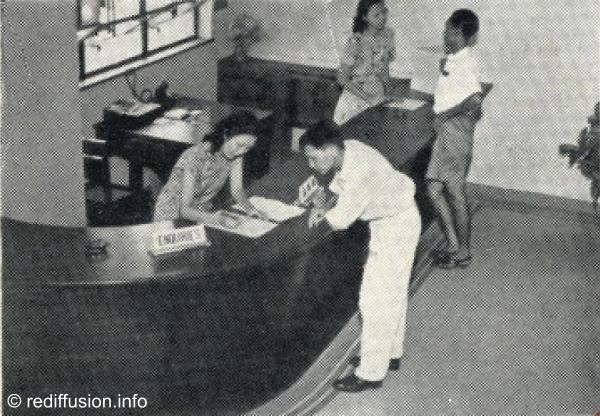 |
Singapore Rediffusion Front Desk |
|
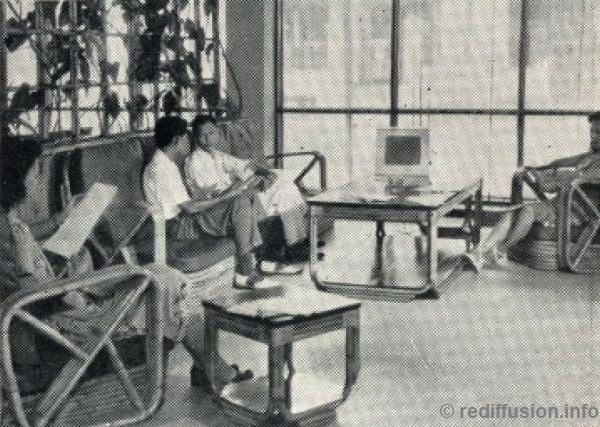 |
Singapore Rediffusion Customer Reception |
|
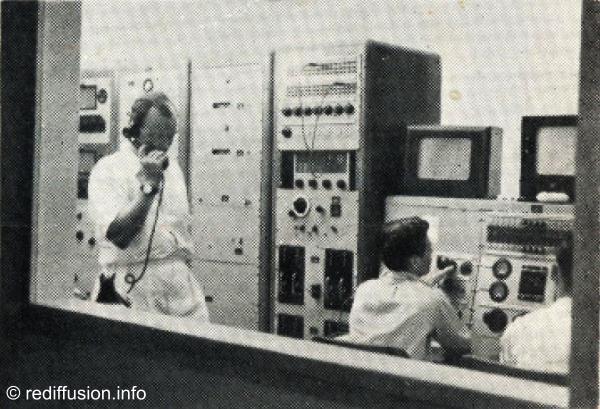 |
Singapore Rediffusion System Control |
|
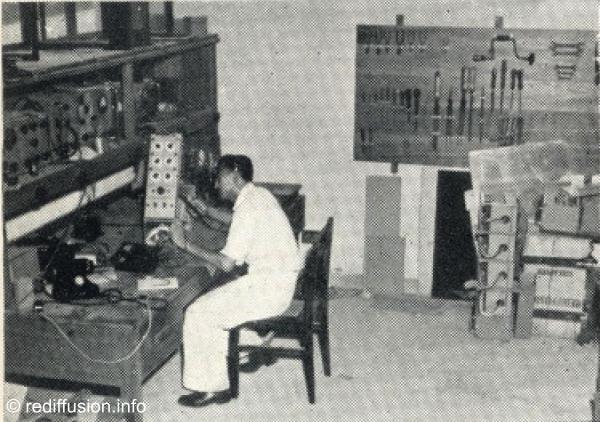 |
Singapore Rediffusion System Workshop |
|
Rediffusion Interior Images from 1950
Click above thumbnail for a larger images
 |
Singapore Rediffusion Front Desk |
|
 |
Singapore Rediffusion Customer Reception |
|
 |
Singapore Rediffusion System Control |
|
 |
Singapore Rediffusion System Workshop |
|
 |
Singapore Rediffusion Front Desk |
|
 |
Singapore Rediffusion Customer Reception |
|
 |
Singapore Rediffusion System Control |
|
 |
Singapore Rediffusion System Workshop |
|
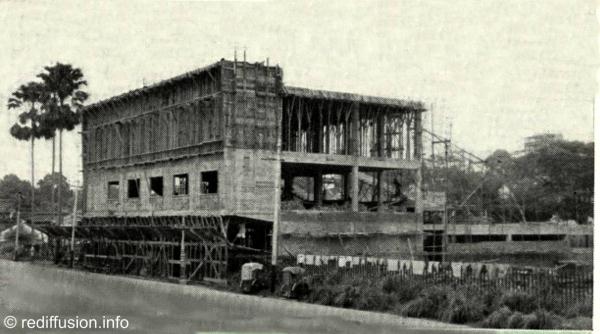 |
Rediffusion Building Construction 1948 |
|
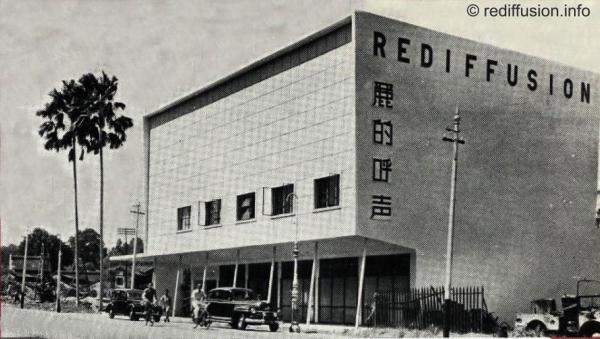 |
Completed Building 1949 |
|
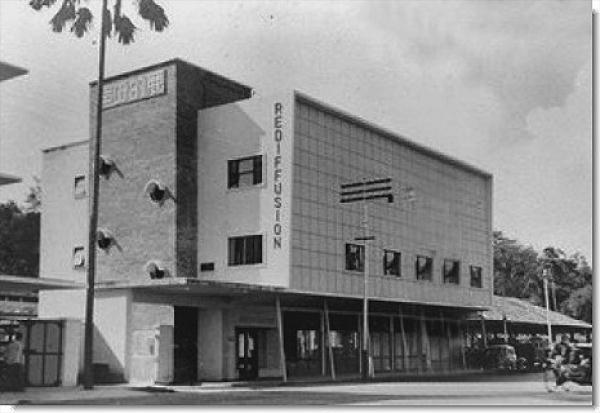 |
Rediffusion Building 1950's |
|
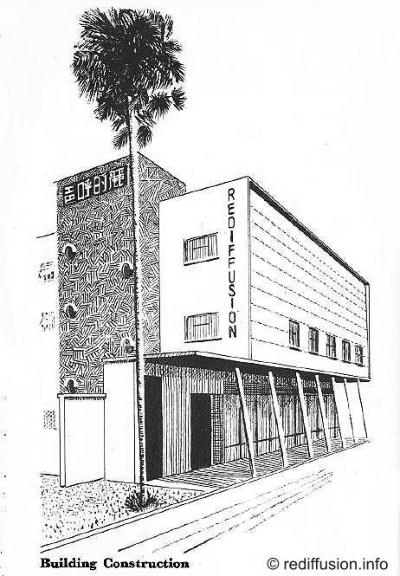 |
The Original Artists Sketch |
|
Studios
Each Studio was fitted with four or six microphone sockets which were wired to the patching panel in the adjacent Balance and Control Cubicle. The layout of the second floor was such that the studios and cubicles alternated with sound-proof windows in each side of the cubicles giving a view into the studios on either side.
Although a cubicle could only control its associated studio directly, the output from the other studio could be selected on the patching panel, either for the purpose of changing studios or for using two together in a dramatic production and so maintaining continuity. This alternating layout had the advantage of providing double sound insulation between any two studios.
Acoustic treatment of the studios was an engineering headache, for the Chinese building contractors could not understand the principles of the materials that were asked for.
The treatment adopted was to have the 4 in. brick walls faced with 2 in. of slagwool, the lower 6 ft. was panelled with Q-in. planks for bass absorption and treble liveliness, and above this, up to the ceiling, the slagwool was faced with Celotex perforated tiles. The latter treatment was also applied to the ceiling. Cork tiles were stuck over the whole area of the boarded floor and acoustic filters were fitted to the air duct apertures. A removable skirting board around all sides enclosed the wiring, cleated to a backboard.
The three studios were identical electrically, so that should a fault occur during a programme, any unit could be interchanged with a spare. As far as possible, the studio layout was also kept the same to avoid confusion to producers or announcers when changing from one cubicle to another.
Other Equipment
The Central Control Room utilized the standard equipment familiar in most Rediffusion stations. All the programme sources, with exception of the three studio outputs and the two local receivers, were passed through leveling up faders and amplifiers. It had been found essential to provide extra metering facilities for lining-up, as the setting up of a temporary outside broadcast would take a long time when the line had to be used alternatively for the sending of tones and for telephone conversation.
Use of the Control Desk monitoring meters in these circumstances would interfere unduly with the operators routine attention to programmes. Once the line characteristics were satisfactory, however, all cross-patching cords were withdrawn, and the O.B. line fed through to the input selector switches on the Control Desk and to each cubicle, via the ring wiring.
The amplifying stations were very similar to the shelter type erected in England. They were powered by A50’s, driven by A93’s. Standard substation bays contained the H.L.L. and feeder switching panels and a tele-monitor unit, amongst other facilities. K20-type assemblies were used at the kiosk distribution points but they were mounted in ferro-concrete kiosks.
Programme Building
A large number of languages and dialects had to be catered for. Amongst those used by different communities were six dialects of Chinese, two of Malay and many Indian, besides English. As the Chinese areas were the most beneficial to develop initially, the Chinese initially formed the greater proportion of the subscribers.
Local talent was mainly limited to Singapore town which provided a large number of musical groups, and the Chinese, always industrious, built up many excellent and varied orchestras. To help in adding variety to the programmes, one of the first permanent O.B. lines linked up to two Chinese theatres and these proved to be very popular.
A total of thirty two programme-hours per day were provided, and it had been rather more easy to arrange material for the English programmes, because of the large resources of recorded American, English, Australian. and European talent which could be drawn on. Requests, however, indicated that the most popular records were limited to those made by a small number of artistes.
The most noticeable difference between subscribers in Singapore and at the UK was the constant demand made for more and more volume. In order to get this, some subscribers tried to tap the service wiring to feed their radiograms and amplifiers. The usual procedure was to stick two pins into the wiring. When a Rediffusion van was seen to enter the street to which
a fault has been traced, it would be at once spotted and the offender would smartly withdraw the pins and hide the wire. The offender would then come out to watch the wiremen looking for the fault and amiably converse with them, offering encouragement and advice.
SINGAPORE


